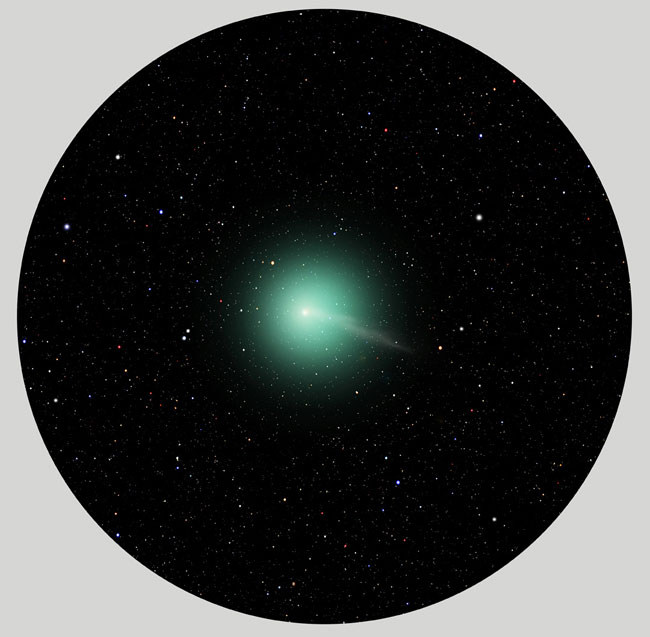Meteors From Comet Hartley 2 Amaze Skywatchers

Stunninglybright fireballs created by meteors from Comet Hartley 2 have amazedskywatchers across the United States lucky enough to spot them.
Thepeanut-shaped comet, which was visitedby a NASA spacecraft yesterday (Nov. 4), made a close pass by Earth on Oct. 20and apparently created a new meteor shower of dust this week.
"Isaw a bright white ball and tail, arcing towards the ocean," said skywatcherHelga Cabral of Seascape, Calif., who spotted a fireball at 9 p.m. local timelast night (Nov. 3). "It was quite beautiful and it looked like it washeaded out to sea and so picture-perfect it could have been a movie!"
Cabral'sobservations and those of other skywatchers were reported this week by theMinor Planet Center at the Harvard-Smithsonian Center for Astrophysics inCambridge, Mass. They come after two fireballs, also likely from Hartley2, were observed on Oct. 16. [Photosof the Oct. 16 fireballs]
Thefireballs are caused by meteors that burn up in Earth's atmosphere before anybits can reach the ground.
CometHartley 2 up close
Ameteor is an object that flares up in Earth's atmosphere. If a piece reachesthe ground, it is called a meteorite. Before they encounter Earth's atmosphere,these objects are known as meteoroids.
Get the Space.com Newsletter
Breaking space news, the latest updates on rocket launches, skywatching events and more!
Comet Hartley 2 is a periodic cometthat completes one trip around the sun every 6 1/2 years. The comet is smalland was discovered in 1986 by Australian astronomer Malcolm Hartley.
Earliertoday, NASA's Deep Impact spacecraft zipped within 435 miles (700 kilometers)of Hartley 2 - the fifth up-close cometflyby ever? and has beamed back stunning photos of the icy wanderer. It was the secondcomet flyby by the Deep Impact spacecraft, which visited Comet Tempel 1 in2005.
Unlikelymeteor show
Lastweek, NASA meteor experts predicted that the chances of seeing any meteors fromComet Hartley 2 would be slim, but said that if they were visible, the besttime to see them would be this week. At the time, Comet Hartley was withinabout 12 million miles (19.3 million km) of Earth, officials with the Centerfor Astrophysics said.
Andapparently, Comet Hartley 2 did not disappoint. [Photo of Comet Hartley 2]
"Iwas in the Revere area about 7:15 last night, driving north on Route 1, when abrilliant object with a tail passed in front of me ? very similar in appearanceto a shooting star, but it appeared much lower to the Earth than a typicalshooting star would be," said skywatcher Teresa Witham, who spotted thefireball late Tuesday from just north of Boston. "If it weren?t for thefact that I had my daughter with me, I'd begin to believe I?d imaginedit."
Anymeteors from Comet Hartley 2 would appear to emanate from a point in the skynear the bright star Procyon in the constellation Canis Minor, near Orion theHunter, which is high overhead in the early hours before dawn.
Cometsare well-known sources of meteor showers because they can sometimes leavetrails of debris streams near Earth's orbital path. When Earth passes throughthese streams, the material can burn up in the atmosphere to create meteorfireballs.
Forexample, the Leonid meteor shower ? which arrives each year in mid-November ?is caused by the remains of the comet Tempel-Tuttle. Two other meteor showers,the Aquarids of May and October's Orionid shower, are caused by the famedHalley's Comet.
- The Best Comet Photosof All Time
- Brief History ofComet Close Encounters
- Returnof the Leonids: Annual Meteor Shower Arrives This Month
Join our Space Forums to keep talking space on the latest missions, night sky and more! And if you have a news tip, correction or comment, let us know at: community@space.com.

Tariq is the Editor-in-Chief of Space.com and joined the team in 2001, first as an intern and staff writer, and later as an editor. He covers human spaceflight, exploration and space science, as well as skywatching and entertainment. He became Space.com's Managing Editor in 2009 and Editor-in-Chief in 2019. Before joining Space.com, Tariq was a staff reporter for The Los Angeles Times covering education and city beats in La Habra, Fullerton and Huntington Beach. In October 2022, Tariq received the Harry Kolcum Award for excellence in space reporting from the National Space Club Florida Committee. He is also an Eagle Scout (yes, he has the Space Exploration merit badge) and went to Space Camp four times as a kid and a fifth time as an adult. He has journalism degrees from the University of Southern California and New York University. You can find Tariq at Space.com and as the co-host to the This Week In Space podcast with space historian Rod Pyle on the TWiT network. To see his latest project, you can follow Tariq on Twitter @tariqjmalik.









